Add this eBook to your basket to receive access to all 217 records. Our indexes include entries for the spelling tristram. In the period you have requested, we have the following 217 records (displaying 161 to 170): These sample scans are from the original record. You will get scans of the full pages or articles where the surname you searched for has been found. Your web browser may prevent the sample windows from opening; in this case please change your browser settings to allow pop-up windows from this site. Missionaries and contributors
(1864)
The Evangelical Magazine and Missionary Chronicle records the work of Christian missionaries throughout the world, and of the supporting missionary societies collecting money for the work in the British Isles. Contributions are listed by congregation, and by family members making donations. | Sample scan, click to enlarge
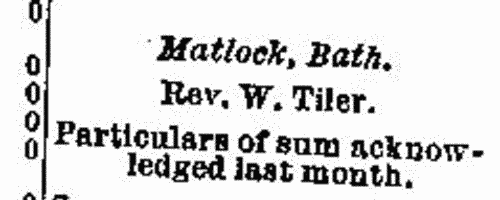
| Boys entering Clifton College
(1866)
Clifton College near Bristol was established in 1862. This edition of the Clifton College Annals and Register for the Old Cliftonian Society by F. Borwick was published in 1925. Boys are listed alphabetically by term of entry, with full names, surname first, in bold. Father's (or widowed mother's) name is given (surname and initials) in capitals, and address. Then there is the name of the house (N. T., North Town; S. H., School House; S. T., South Town), first and last forms, distinctions in school work and games, and month of leaving. Where known, the editor then gave a career summary with month of death; or, if still living, address as in 1925 (in italics). | Sample scan, click to enlarge
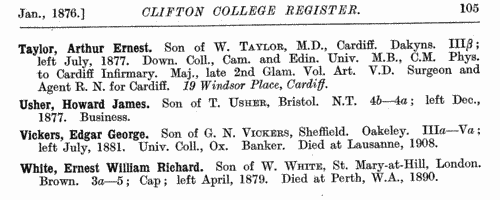
|  Men of the 40th Regiment who fought in the New Zealand War
(1863-1870) Men of the 40th Regiment who fought in the New Zealand War
(1863-1870)
New Zealand War Medal roll for the 40th (2nd Somersetshire) Regiment of Foot: for service in the New Zealand campaign 1863 to 1866: the rolls were compiled following a general order in 1869 and the medals were distributed in 1870. The regiment, although called the 2nd Somersets, was based at Birr in Offaly. It embarked for New South Wales 14 July 1852, and was moved to New Zealand in 1860; the men returned to England in 1866, and thence back to Ireland in 1869. | Sample scan, click to enlarge

| Boys entering Loretto School
(1870)
The Reverend Dr Thomas Langhorne, who came to Musselburgh in Midlothian as an Episcopalian Church clergyman, established a small school for boarders and day scholars at Loretto House, so called because the grounds contained the ruins of the mediaeval chapel of St Mary of Loretto. To celebrate the centenary of the school in 1925, a second edition of the school register was published, edited by A. H. Buchanan-Dunlop. Relatively little was known of many of the earliest scholars, but from 1835 onwards the register generally gives full name, in capitals, surname first; date of birth; period of time at Loretto; a brief biography; date of death; whether brother of any other boy in the register; and a sequential number. | Sample scan, click to enlarge
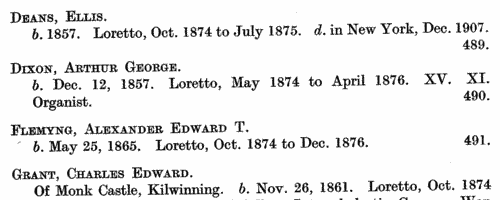
| Patentees of New Inventions
(1870)
Index of patentees and applicants for patents of inventions in 1870: giving full name of patentee (surname first); number of patent (in bold); date (within 1870); and subject-matter. Where the patentee was acting as agent for third parties, their names are given in italics in the subject-matter column. | Sample scan, click to enlarge

| Boys entering Giggleswick School
(1872)
The school at Giggleswick in the West Riding of Yorkshire dates from at least 1507, but no register of the boys attending there has survived earlier than one started by the headmaster, the reverend George Style, in 1875. When the bursar, H. L. Mullins, prepared this, 'The Giggleswick School Register', printed in 1913, he was able to compile general details of some scholars from earlier years, but the concerted, reasonably complete, account starts in 1859. The details are arranged by term of entry, then alphabetically by surname and christian name. Typically each description gives full name; date of birth; name and address of father; date of leaving. Where known, Mullins then added a brief career synopsis, present address in 1913, or date of death. From 1869 onwards boarders were admitted to the school, and where it is known that a boy was a day scholar, the word (Town) is added after his name. | Sample scan, click to enlarge
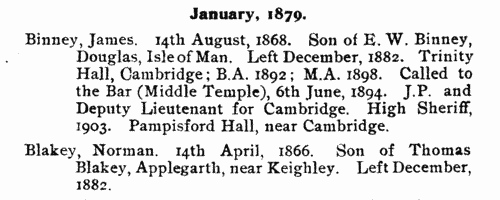
| Baptists
(1873)
The Baptist was a weekly newspaper, with some general news and political coverage, but mainly devoted to chronicling Denominational Intelligence, i. e. the doings of the Baptist churches in Britain and Ireland. January to June 1873. | Sample scan, click to enlarge
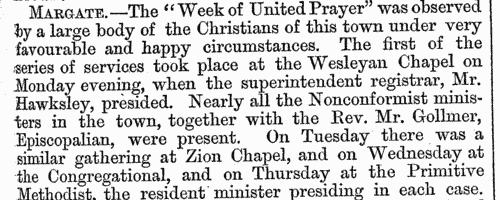
| Union Bank of London Shareholders
(1873)
Copy of the return by the Union Bank of London to the Inland Revenue listing the 'persons of whom the Company or partnership consists', pursuant to 7 & 8 Vic. cap. 32: giving full name (surname first), residence and occupation (often not stated). | Sample scan, click to enlarge

|  Outstanding soldiers of the 51st (2nd Yorkshire West Riding) Regiment of Foot (The King's Own Light Infantry)
(1870-1875) Outstanding soldiers of the 51st (2nd Yorkshire West Riding) Regiment of Foot (The King's Own Light Infantry)
(1870-1875)
Each year just a handful of outstanding soldiers of the regiment were chosen for good conduct medals and gratuities: these are listed here. There were two lists, one for men recommended for the Good Conduct Medal without a gratuity, and one for gratuities - £5 to a private, £10 to a corporal, and £15 to a serjeant. Both lists are indexed here, and each gives rank, name, regimental number, date of recommendation and date of issue. (The sample scan is from the 32nd foot). The regiment was sent out to India in 1872. | Sample scan, click to enlarge
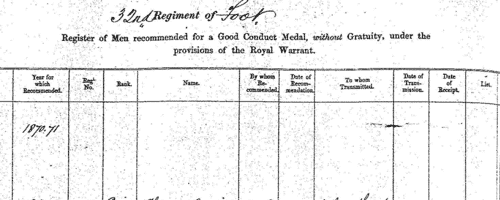
| Boys entering Clifton College
(1875)
Clifton College near Bristol was established in 1862. This edition of the Clifton College Annals and Register for the Old Cliftonian Society by F. Borwick was published in 1925. Boys are listed alphabetically by term of entry, with full names, surname first, in bold. Father's (or widowed mother's) name is given (surname and initials) in capitals, and address. Then there is the name of the house (N. T., North Town; S. H., School House; S. T., South Town), first and last forms, distinctions in school work and games, and month of leaving. Where known, the editor then gave a career summary with month of death; or, if still living, address as in 1925 (in italics). | Sample scan, click to enlarge
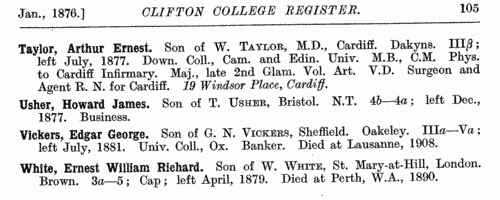
|
Research your ancestry, family history, genealogy and one-name study by direct access to original records and archives indexed by surname.
|












